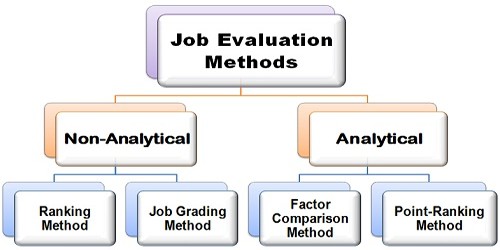Job evaluation is the systematic process for assessing the relative worth of jobs within an organization. It is the technique of analysis and assessment of jobs to determine their relative value within the firm so that a fair wage and salary structure can be established for various jobs. The main objective of job-evaluation is to have external and internal consistency in wages structure.
Analytical evaluation schemes are schemes where jobs are broken down into components (known as factors) and scores for each component of the job are awarded a final total giving an overall rank order.
Analytical Job Evaluation Methods
Factor-Comparison Method: Under this method, the job is evaluated, and the ranks are given on the basis of a series of factors Viz. Mental effort, physical effort, skills required supervisory responsibilities, working conditions, and other relevant factors. Use of the Factor Comparison method of job evaluation is not as widespread as the Points Rating systems because the use of points enables a large number of jobs to be ranked at one time. These factors are assumed to be constant for each set of jobs.
An advantage of the factor-comparison methods that jobs of unlike nature – for example, manual, clerical, and supervisory – may be evaluated with the same set of factors. But the method is complicated and expensive. Thus, each job is compared against each other on this basis and is ranked accordingly. The advantage of this method is that it is consistent and less subjective, thus appreciable by all. But however, it is the most complex and an expensive method.
Point-Ranking Method: Under this method, each job’s key factor is identified and then the subfactors are determined. These sub-factors are then assigned the points by its importance. For example, the key factor to perform a job is skills, and then it can be further classified into sub-factors such as training required, communication skills, social skills, persuasion skills, etc.
The more demanding the job, the higher the points value. This scheme has the following advantages:
- it provides a rationale why jobs are ranked differently
- it may be entered as a defense to an equal value claim
- it will be seen generally as less subjective than nonanalytical techniques.
The point ranking method is less subjective and is an error-free as the rater sees the job from all the perspectives. But however, it is a complex method and is time-consuming since the points and wage scale has to be decided for each factor and the subfactors.
Information Source:
















